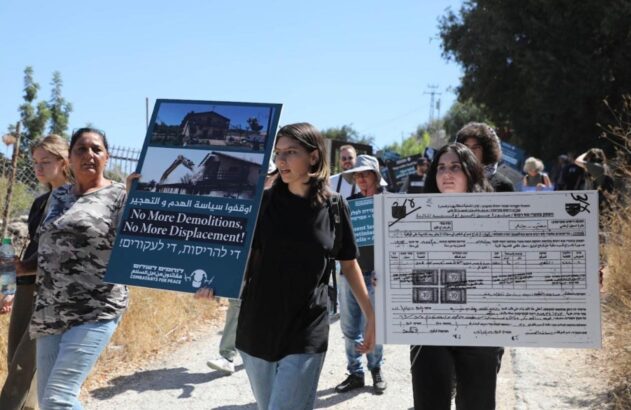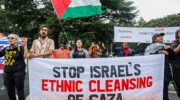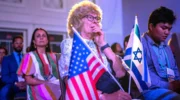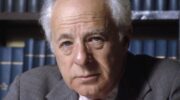As global attention on the war in Gaza wanes, an intensifying ethnic cleansing campaign is ramping up in the West Bank.
by Murtaza Hussain, reposted from Drop Site News, August 13, 2024
Alice Qaysiya’s family property in the West Bank city of Bethlehem once hosted not just their home but a restaurant they had built. That was before settlers vandalized and demolished it. Now it is home to a makeshift campground the family guards fiercely.
While the world’s attention drifts from the assault on Gaza, the rapidly accelerating seizure of Palestinian land in the West Bank continues in the hidden background, reshaping conditions on the ground and pushing a political settlement to the conflict further away.
The Qaysiya family isn’t leaving without a fight, and their determined stand has drawn the support of some Israelis and Western activists, who are now putting their bodies on the line to slow the rampage of Israeli settlers.
The Qaysiya family has gone to court numerous times to try and assert legal protection over the property, only to see those claims ignored on the ground by settler activists guarded by Israeli soldiers. The settlers recently began arriving on her family property with weapons as part of the confiscation effort. Drop Site News put together the following account based on interviews with the Qaysiya family and witnesses to the stand-off, backed up by video of the resulting violence.
“This is the last green area in Bethlehem and they are planning to take it. We have been sleeping here in tents since they demolished our house, but we cannot leave since we know that if we do they will take it from us,” Qaysiya told Drop Site. “They took advantage of the war, while the media was busy, and they thought if they did this now it would not create media pressure.”

A number of representatives from the group Combatants for Peace, a mixed group of former Israeli and Palestinian combatants-turned-solidarity-activists have attempted to physically block settlers from displacing the Qaysiya family from their property. In recent days armed soldiers have arrested demonstrators or physically coerced them off the site. Meanwhile, more settlers have arrived, who have vandalized the Qaysiya’s remaining property, including a statue of the Virgin Mary owned by the family that was found smashed at the site.
In videos from the property shared with Drop Site, groups of settlers, guarded by IDF soldiers, can be seen mocking the family and activists who have come to defend them, while trying to break into a gate surrounding their land.
The war in Gaza has drawn the bulk of international attention in the Middle East since it began last October. Yet the conflict has also triggered a more intense campaign of violence and displacement in the West Bank, where Israeli settlers, often supported by the military, are waging a campaign to drive out Palestinian landholders by force and expand their footprint over territory allocated by international law to a future Palestinian state.
Palestinians in tents are little obstacle for Israeli settlers, but the addition of Western solidarity activists to the mix has heightened the global stakes of the confrontation. An American passport, however, is no protection from violence at the hands of the IDF or its settler allies.
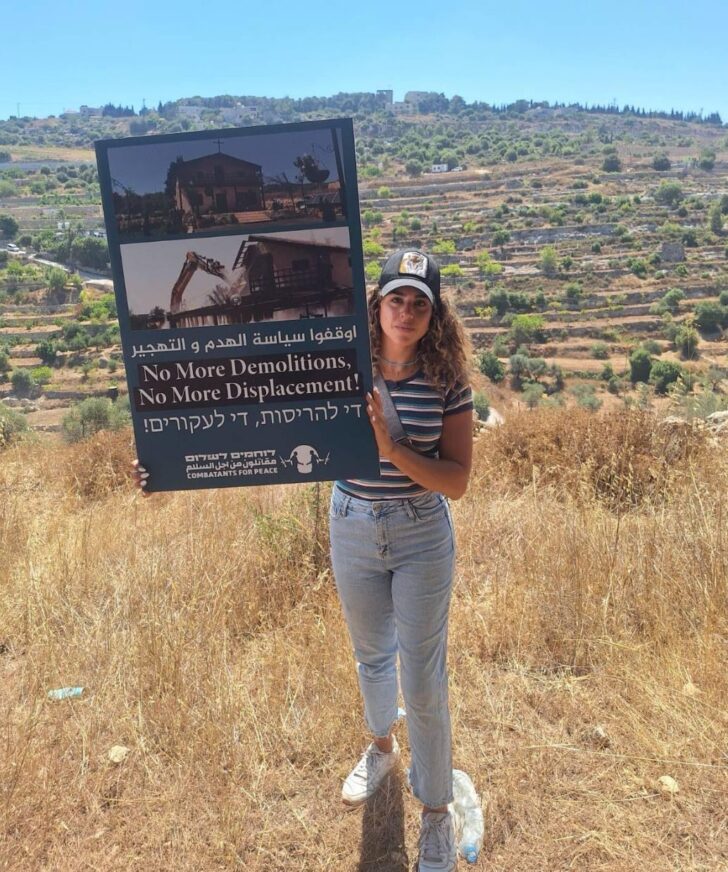
Last Friday, Amado Sison, an activist from New Jersey with the solidary group Faz3a, joined fellow demonstrators near the West Bank village of Beita. In an interview with Drop Site after being discharged from the hospital, Sison said he was taking part in a “protective presence” exercise aimed at defending Palestinian citizens living in the West Bank from settler and military violence. “The Palestinians were holding a rally and doing chants, when Israeli soldiers at a nearby outpost started shooting tear gas and aiming weapons at us,” said Sison. “This was only my second demonstration, but some of the more experienced demonstrators shouted that live rounds were being fired and everyone began to run.”
Sison and others ran from the gunfire into a nearby olive grove. It was then that he felt a “blunt impact” in the back of his leg. He initially thought he had been hit by a tear gas canister. It turned out to have been a live bullet, which entered his thigh and exited from the front of his leg. In video of the incident taken by Anthony C., an activist with Faz3a, and provided to Drop Site, a group of protesters and local Palestinians can be seen screaming as they attempt to carry a wounded Sison to safety after the shooting.
Jonathan Pollak, an Israeli volunteer who was at the scene of the shooting, described it as an unprovoked attack on fleeing protesters by IDF soldiers. “The soldiers attacked with tear gas and concussion grenades, before moving on to live ammunition,” Pollak said. “They chased the demonstrators into a nearby olive grove, which is where Amado was shot. He was hit in the back of the thigh. He was shot while his back was to the soldiers.”
Pollak and another group of activists carried Sison over 500 yards to a pickup truck which evacuated him to a hospital in the West Bank city of Nablus.
The shooting incident was just one of many violent attacks in Beita, where where Pollak says that over 17 people have been killed since 2020. This June, the Israeli government reportedly gave de facto approval to settlers to repopulate an illegal settlement outpost on the territory under protection of the IDF after it had been evacuated in 2021.
“It’s an awful thing to happen to anyone,” Pollak said about the shooting of Sison. “He’s also an American citizen. If he is shot like that just imagine the level of violence being employed against Palestinians.” Since October 7, over 500 Palestinians have been killed in the West Bank, with thousands more wounded, as a campaign by Israeli settlers to seize territory there accelerates against the backdrop of the war in Gaza.
“We are aware of these reports involving a U.S. citizen in the West Bank and are in contact with local authorities to gather more information,” a State Department spokesperson told Drop Site in respond to a request for comment on Sison’s shooting. “We are greatly concerned when any U.S. citizen is harmed overseas and work to provide consular assistance. We reiterate our advice to U.S. citizens to reconsider travel to the West Bank. Over the past few months, there has been an increase in extremist violence and military activity. Due to privacy considerations, we have no further comment.”
After being shot, Sison was treated and discharged from the hospital in Nablus. He was lucky: The bullet that struck his thigh, a dangerous place to be shot, did not hit any major arteries or bone. While unable to put pressure on his leg, he is able to walk with the aid of crutches and is expected to recover from the incident.

In a statement about the shooting reported in the Israeli press, a spokesperson for the IDF stated that troops had “used riot dispersal means and fired live rounds in the air to disperse” a “gathering” in the area near the settlement outpost. The statement added that, “a report was received regarding a foreign national who was accidentally injured by the riot dispersal means and was evacuated to the hospital.”
A number of Americans have been killed or wounded by the IDF in recent years, including both Palestinian citizens living in or visiting the West Bank, and U.S. activists like Sison. Earlier this month, the U.S. government announced that it would not pursue Leahy Act sanctions against an Israeli military unit, the Netzah Yehudah battalion, implicated in the death of an elderly Palestinian-American man, Omar Assad, who died after being bound and left exposed to the elements by soldiers from the unit. Two Palestinian-American teenagers, Mohammad Ahmad al-Khdour and Tawfic Abdel Jabbar, have also been killed in separate shooting incidents by the IDF in the West Bank since the start of this year.
The U.S. government has taken some halting steps in recent months to sanction particularly violent settler leaders. The sanctions stop some individuals and groups associated with the most extreme fringe of the settler movement from accessing the U.S. financial system, while also targeting selected “outposts” in the West Bank for blacklisting by banks. The Biden administration, which is being sued over the sanctions by pro-settler groups in the U.S., has hinted that these limited sanctions measures could theoretically expand in the future to target more of the settlement enterprise.
But analysts say that at present these polices are not nearly enough – especially as the settler movement is no longer a fringe but now backed directly by powerful Israeli government officials, including the current Israeli Minister of National Security, Itamar Ben-Gvir.
“The permission structure that allows these kinds of attacks comes from the most senior ranks of the Israeli government. Ministers like Itamar Ben-Gvir and [Finance Minister] Bezalel Smotrich have made no secret of their support for annexing the West Bank and their backing of settlers who aim to do so through piecemeal violence, home by home,” said Sara Haghdoosti, Executive Director of Win Without War, a DC-based foreign policy advocacy group. “It is good that the Biden administration has created and used tools to sanction people responsible for settler violence in the West Bank, but it is not enough. The longer Ben-Gvir and Smotrich continue receiving tacit US support, the more right wing settlers will see their attacks as being well worth the small cost they’ve paid thus far.”

For his part, Sison says that despite being shot by the IDF while attempting to resist the settlement project, he will not be deterred from participating in future protective presence actions aimed at defending Palestinians from violence. He brought up numerous recent cases where Palestinian children have been able to use playgrounds and farmers have been able cultivate their lands thanks to the presence of foreign and Israeli volunteers acting as a buffer between Palestinians, settlers, and IDF soldiers. These efforts have often come at great personal risk to the activists themselves, who are frequently assaulted by soldiers and settlers operating under their protection.
While President Biden has promised U.S. retaliation for violent attacks targeting Americans elsewhere in the region, there has been near radio silence over a steady drumbeat of violence incidents that have affected U.S. citizens in the West Bank at the hands of the Israeli military or settler groups. That selective interest and concern by the U.S. government over violence targeting its own citizens has frustrated Sison.
“Biden has said that if any U.S. citizen is attacked, we will respond,” he said. “Yet there have been multiple times now where this hasn’t been the case.”
The violence in the West Bank looks set to escalate, as international attention remains focused on the war in Gaza and fear of the conflict spreading to Lebanon and Iran. That distraction has proven to be a boon for the settler movement, which has also been emboldened by support from powerful members of the Israeli government.
Qaysiya, the Bethlehem resident under threat from settlers, said she fears that it is only a matter time before they are forced to give up property that they have held in their family for years. Even children have gotten involved.
“There are young settler kids also coming who are only around 12 years old with knives and guns,” Qaysiya said. “It is really something shameful that these settler organizations are using these kids, telling them they will be rewarded and taking advantage of them.”
Murtaza Hussain is a Brooklyn-based journalist
RELATED ARTICLES:
- Israel has turbocharged West Bank housing demolitions under the cover of war
- While Gaza suffers physical genocide, the West Bank faces economic genocide
- Why the West Bank is on the verge of economic collapse
- ‘Nowhere is safe’: Fear and mourning inside the West Bank villages where Israeli settlers went on the rampage
- Genocide alert issued over Israeli violence in West Bank
- Israeli media: Palestinians recount settler, army torture amid surge in West Bank expulsions
- It’s not just Gaza – Israel is also killing scores in the West Bank

